For the seventh day of Cinefest, the 17th International Festival of German Film-Heritage, EFSP selected Marten Toonder (1912-2005), the creator of the Dutch comic strip 'Tom Poes & Oliver B. Bommel' and the father of the Dutch animation film. In 1942, he founded an animation film studio together with puppeteer Joop Geesink. During the Nazi occupation, he worked for the Ufa on the Dutch-German production, Tom Puss. Das Geheimnis der Grotte/Tom Poes en het geheim van de grot/Tom Puss and the secret of the cave (1942-1944). Many animation films would follow. The black and white comics of Tom Puss were so popular that in 1942 8 stories were issued as colour postcards.
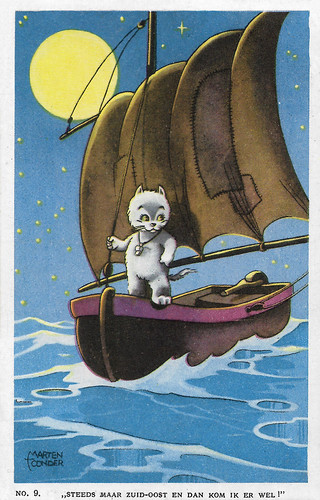
Dutch postcard by Ed. De Muinck & Co., Amsterdam. Tom Poes (Tom Puss) by Marten Toonder, Series 2 'De Toverpijp' (The Magic Pipe), card no. 9. Sent by mail in 1943. Caption: Always South-East and I'll get there.
'Tom Poes en de Toverpijp' (Tom Puss and the Magic Pipe), in book editions/parlance shortened to 'The magic pipe', is the second story from the Bommelsaga, written and drawn by Marten Toonder. The story first appeared on 10 June 1941 and ran until 11 July of that year. The hiatus of more than two months in the Telegraaf was the result of after-censorship by the German occupier. The theme of the story is aid to the enemy.
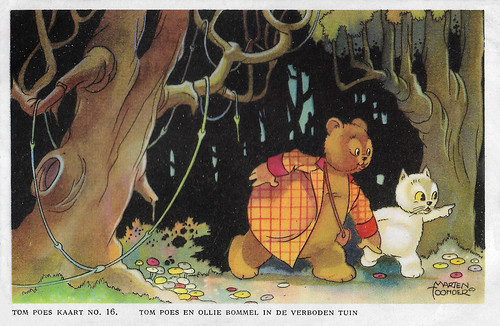
Dutch postcard by Ed. De Muinck & Co., Amsterdam. Tom Poes (Tom Puss) by Marten Toonder, Series 3 'De Tovertuin' (The Magic Garden), card no. 16. Sent by mail in 1943. Caption: Tom Puss and Oliver B. Bumble in the forbidden garden.
'Tom Poes in de tovertuin' (Tom Puss in the Magic Garden), in book editions/parlance shortened to 'The Magic Garden' is the third story from the Bommelsaga, written and drawn by Marten Toonder. The story first appeared on 12 July 1941 and ran until 13 August of that year. In this story, Tom Puss meets Oliver B. Bumble and the wizard Hocus P. Pas for the first time.

Dutch postcard by Ed. De Muinck & Co., Amsterdam. Tom Poes (Tom Puss) by Marten Toonder, Series 4 'Tom Poes en het verdwijneiland' (The disappearing island), card no. 21. Sent by mail in 1957. Caption: An island that is not on the map.
'Tom Poes en het verdwijneiland' (Tom Puss and the disappearing island), in book editions/parlance shortened to 'The disappearing island', is a story from the Bommelsaga, written and drawn by Marten Toonder. The story first appeared on 18 October 1941 and ran until 19 November of that year. The theme is dangerous sea shipping. In this story, two more or less permanent characters make their debut: Captain Wal Rus and the evil professor Sickbock.
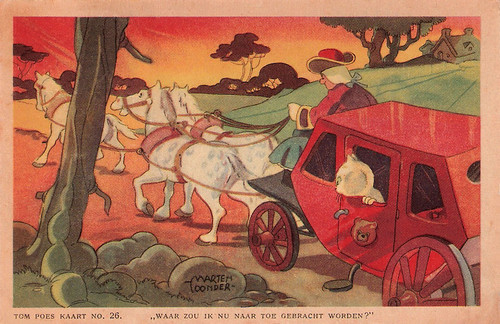
Dutch postcard by Ed. De Muinck & Co., Amsterdam. Tom Poes (Tom Puss) by Marten Toonder, series 5 'De Drakenburcht' (The Dragon Court), card no. 26. Caption: Where would I be taken now?
'Tom Poes en De Drakenburcht' (Tom Puss and the Dragon Court) (in book editions shortened to 'The Dragon Court') is a story from the Bommelsaga, written and drawn by Marten Toonder. The story first appeared on 16 September 1941 and ran until 17 October of that year. This is the first story in which Bommelstein Castle plays a role.

Dutch postcard by Ed. De Muinck & Co., Amsterdam. Tom Poes (Tom Puss) by Marten Toonder, series 5 'De Drakenburcht' (The Dragon Court), card no. 28. Sent by mail in 1944.
'Tom Poes en De Drakenburcht' (Tom Puss and the Dragon Court) (in book editions shortened to 'The Giant Bird') is a story from the Bommelsaga, written and drawn by Marten Toonder.
Marten Toonder was born in Rotterdam, The Netherlands, in 1912. Toonder was introduced to comics through the comics his father, who was a sea captain, brought from the United States.
After his final exams, in 1931, he went to Buenos Aires with his father. There he got acquainted with Jim Davis, the assistant of the well-known Argentine artist and editor Dante Quinterno, who ran a studio producing comics. Quinterno's creations impressed him to such a degree that he decided to become an artist himself.
In 1935 he married Afine Kornélie Dik, originally a girl next door from his youth who, under the name Phiny Dick, drew and wrote comics and children's books herself. She also made texts for her husband's drawings for the comic 'Kappie'.
In 1938 Roonder's first comic appeared in a Swedish newspaper. His most famous comic series would become the 'Tom Poes & Olivier B. Bommel' (Tom Puss and Oliver B. Bumble) series. From 1941 until 1986, it appeared in De Telegraaf, a Dutch newspaper.
The comic series has a very characteristic format. Every day there were three drawings and an accompanying text (about a book-page long). 177 Bommel stories have been published as a comic book novel, of which selections were later re-released in book form several times. They are usually referred to by the term 'Bommelsaga' or 'daily newspaper strips'.
Tom Poes & Olivier B. Bommel started out as a children's cartoon but gradually became more relevant to adults. Nowadays his texts are considered literature by some critics, and Toonder received several literary prizes for them. He invented many new words and expressions and some of those are now widely used in the Dutch language.

Dutch postcard by Ed. De Muinck & Co., Amsterdam. Tom Poes (Tom Puss) by Marten Toonder, series 7 'De reuzenvogel' (The Giant Bird), card no. 38.
'Tom Poes en De Reuzenvogel' (Tom Puss and the Giant Bird) (in book editions shortened to 'The Giant Bird') is a story from the Bommelsaga, written and drawn by Marten Toonder. The story first appeared on 20 November 1941 in De Telegraaf and ran until 21 December of that year. The theme of the story is food robbery. Although Toonder was not allowed to deal with topical issues, in the period 1941-1944 he continued to walk along the edge of a ban.
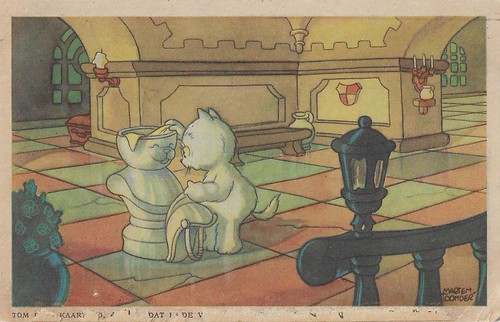
Dutch postcard by Ed. De Muinck & Co., Amsterdam. Tom Poes (Tom Puss) by Marten Toonder, Series 7 'De reuzenvogel' (The Giant Bird), card no. 40.
Despite German censorship, hidden messages were inserted. In 'Tom Poes en De Reuzenvogel' (Tom Puss and the Giant Bird), Tom Poes discovers that the wizard Hocus Pas is using Olivier B. Bommel's castle as a hideout for a giant bird. Every night the bird steals grain from the farmers, so the wizard can make a potion that will impose his will on everybody.
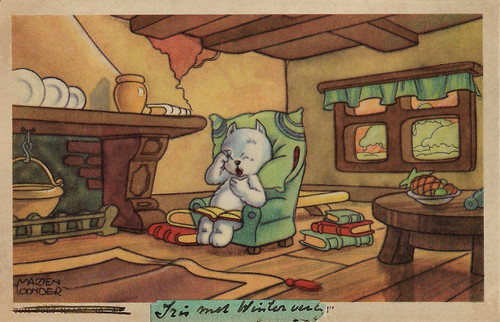
Dutch postcard by Ed. De Muinck & Co., Amsterdam. Tom Poes (Tom Puss) by Marten Toonder, Series 8 'Tom Poes en de rare uitvinding' (The Weird Invention), card no. 43. Sent by mail in 1944.
'Tom Poes en de rare uitvinding' (Tom Puss and the Weird Invention - in book editions/parlance shortened to 'The weird Invention', is a story from the Bommelsaga, written and drawn by Marten Toonder. The story first appeared on 23 December 1941 and ran until 27 January 1942. The theme of the story is mass hypnosis. This is a covert reference to Joseph Goebbels' propaganda.
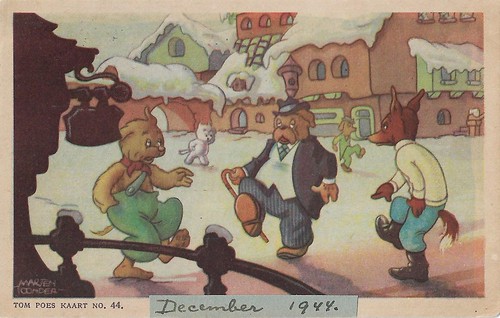
Dutch postcard by Ed. De Muinck & Co., Amsterdam. Tom Poes (Tom Puss) by Marten Toonder, Series 8 'Tom Poes en de rare uitvinding' (Tom Puss and the Strange Invention), card no. 44. Ed. De Muinck & Co., Amsterdam, 1943. The postcard was written on 20 May 1945 (after the Dutch Liberation) but refers to December 1944.
'Tom Poes en de rare uitvinding' refers to mass hypnosis and was considered to secretly refer to Joseph Goebbels, Hitler's Minister of Propaganda. The comics appeared in the daily De Telegraaf between 23 December 1941 and 27 January 1942.
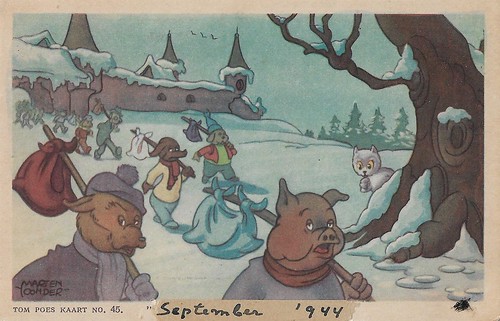
Dutch postcard by Ed. De Muinck & Co., Amsterdam. Tom Poes (Tom Puss) by Marten Toonder, Series 8 'Tom Poes en de rare uitvinding' (Tom Puss and the Strange Invention), card no. 45. The postcard was written on 20 May 1945 (after the Dutch Liberation) but refers to September 1944.
The plot of 'Tom Poes en de rare uitvinding' deals with the city of Rommeldam turned into a city of sleepwalkers. The next day all the inhabitants leave the city and start wandering. Tom Poes discovers this is all an experiment of Prof. Sickbock and criminal Pietje Kolibrie and his gang to rob the houses of all inhabitants by use of a hypnotising mirror and transmission masts. Whoever wears rubber boots is immune to the hypnosis. In the end, Tom Poes arranges that the Professor and the criminal gang are arrested.
In 1942, Marten Toonder founded a film studio together with film producer Joop Geesink. Toonder was mainly concerned with cartoons and Geesink was more into puppet films.
In 1943, Toonder founded Toonder Studio's, a company that was an offshoot of Toonder-Geesink production. The company initially focused on the release of comics but later moved into advertising and animation films as well.
A number of the Tom Poes & Olivier B. Bommel stories have been released in the cinema as animation films, but these were not very successful. The first one was the Dutch-German production, Tom Puss. Das Geheimnis der Grotte/Tom Poes en het geheim van de grot (Maarten Toonder, 1942-1944). The animation films did have the fun but lacked the subtler humour that the stories convey.
An exception may be the animated feature Als je begrijpt wat ik bedoel/If you understand what I mean (Harrie Geelen, Bjørn Frank Jensen, Bert Kroon, 1983) after the collection of stories of the same name. This animation film received a compliment from Walt Disney and Warner Bros. However, Marten Toonder himself was not entirely happy with the film.

Dutch postcard by Ed. De Muinck & Co., Amsterdam. Image: Marten Toonder. Caption: Happy New Year.
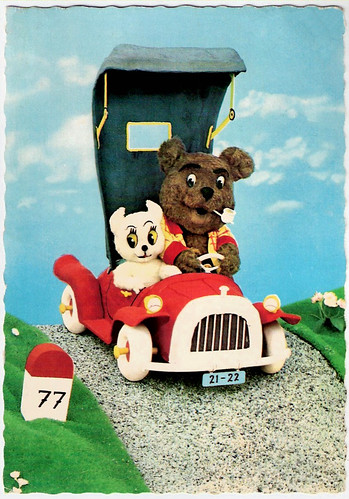
Dutch postcard by GRAVO / Gebr. Spanjersberg N.V., Rotterdam. Image: Marten Toonder. Sent by mail in 1961.
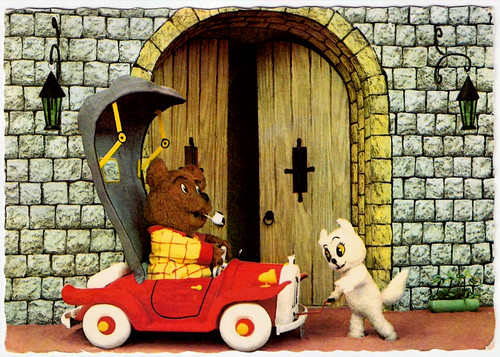
Dutch postcard by GRAVO. Image: Marten Toonder.
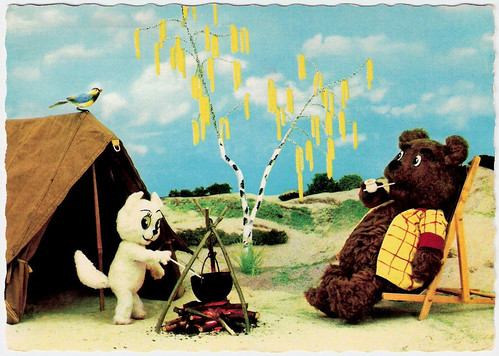
Dutch postcard by GRAVO. Image: Marten Toonder.
From 1960, Tom Poes & heer Bommel (Tom Puss and Lord Bumble) experienced two adventures on television with 'Tom Poes en het echoputje' (Tom Puss and the little echo pit) and 'De schatkaart van opa Bastiaan' (The treasure map of grandfather Bastiaan). Marten Toonder and his closest collaborator Lo Hartog van Banda conceived and wrote the stories.
It was not their first collaboration on television because in 1958 Lo Hartog van Banda had already adapted the comic strip 'Panda and the master tinkerer' into a television series.
The series was a collaboration between Toonder Studios and Bert Brugman's marionette theatre. Coincidentally, Brugman was Marten Toonder's neighbour in the city of Blaricum. The first series took place in Rommeldam and surroundings, but Tom Poes & heer Bommel made long journeys to strange locations for the second story.
The comic was mainly read by adults, so the television series had to be tailored entirely to the small viewer. So a lot had to be done in half an hour.
In 1964 Toonder moved with his wife to Greystones, Ireland, to devote himself entirely to cartoon drawing. He was surprised to find that the Irish landscape was very similar to what he had drawn in his Bommel comics for years.
Phiny Dick died in 1990, and in 1996 Toonder remarried the composer Tera de Marez Oyens, who later that year died of an incurable disease - just like his first wife. Since then Toonder has lived in the Rosa Spier Huis in Laren. In 2005, Marten Toonder died in his sleep at the age of 93. He is buried in Greystones' Redford Cemetery.
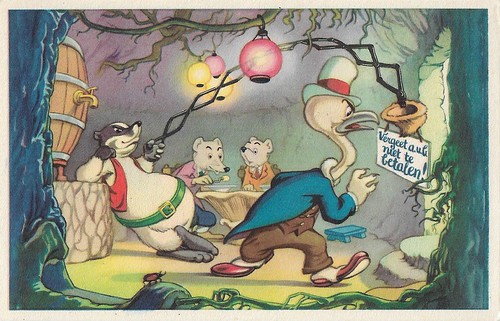
Dutch postcard by Marten Toonder Studios. Doremias Das (1952), no. 8 of 10, designed by Wim Lensen (1914-1993).

Dutch postcard by Marten Toonder Studios. Doremias Das (1952), no. 10 of 10, designed by Wim Lensen.
The plot of this postcard series of the comic Doremias Das (1952) is about a friendly but sharp badger called Doremias, who likes music. He owns a fancy restaurant in the woods, which he even remodels to attract clients. A client is treated to tasteful food and fresh drinks, and even music (though requiring an extra payment). When the client leaves without payment, the badger has the means to remind him. The last card shows what happens to whoever doesn't pay. On the back of each card, each episode is indicated as a rhyming couplet.
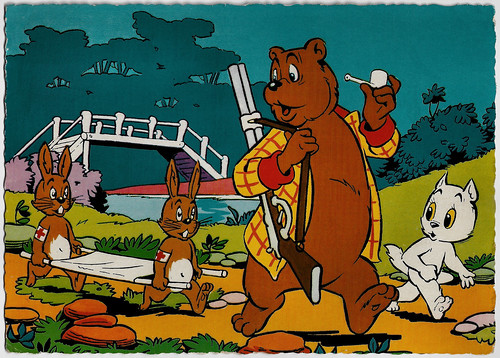
Dutch postcard by Vita Nova, Schiedam / Gebr. Spanjerberg, Rotterdam. Image: Marten Toonder Studio's. Caption: Lord Bumble wants to stop hunting. He doesn't see a chance to hit a hare. The hares themselves do not see that way and prefer not to take any risks.
Dutch film news item on the Marten Toonder Studio's (1973). Source: Nederlands Instituut voor Beeld en Geluid (YouTube).
Dutch trailer for Als je begrijpt wat ik bedoel/If you understand what I mean (1983). Source: Kneiter FM (YouTube).
On 25 November, EFSP will present a post on Joop Geesink.
Sources: Wikipedia (Dutch and English) and IMDb.

Dutch postcard by Ed. De Muinck & Co., Amsterdam. Tom Poes (Tom Puss) by Marten Toonder, Series 2 'De Toverpijp' (The Magic Pipe), card no. 9. Sent by mail in 1943. Caption: Always South-East and I'll get there.
'Tom Poes en de Toverpijp' (Tom Puss and the Magic Pipe), in book editions/parlance shortened to 'The magic pipe', is the second story from the Bommelsaga, written and drawn by Marten Toonder. The story first appeared on 10 June 1941 and ran until 11 July of that year. The hiatus of more than two months in the Telegraaf was the result of after-censorship by the German occupier. The theme of the story is aid to the enemy.

Dutch postcard by Ed. De Muinck & Co., Amsterdam. Tom Poes (Tom Puss) by Marten Toonder, Series 3 'De Tovertuin' (The Magic Garden), card no. 16. Sent by mail in 1943. Caption: Tom Puss and Oliver B. Bumble in the forbidden garden.
'Tom Poes in de tovertuin' (Tom Puss in the Magic Garden), in book editions/parlance shortened to 'The Magic Garden' is the third story from the Bommelsaga, written and drawn by Marten Toonder. The story first appeared on 12 July 1941 and ran until 13 August of that year. In this story, Tom Puss meets Oliver B. Bumble and the wizard Hocus P. Pas for the first time.

Dutch postcard by Ed. De Muinck & Co., Amsterdam. Tom Poes (Tom Puss) by Marten Toonder, Series 4 'Tom Poes en het verdwijneiland' (The disappearing island), card no. 21. Sent by mail in 1957. Caption: An island that is not on the map.
'Tom Poes en het verdwijneiland' (Tom Puss and the disappearing island), in book editions/parlance shortened to 'The disappearing island', is a story from the Bommelsaga, written and drawn by Marten Toonder. The story first appeared on 18 October 1941 and ran until 19 November of that year. The theme is dangerous sea shipping. In this story, two more or less permanent characters make their debut: Captain Wal Rus and the evil professor Sickbock.

Dutch postcard by Ed. De Muinck & Co., Amsterdam. Tom Poes (Tom Puss) by Marten Toonder, series 5 'De Drakenburcht' (The Dragon Court), card no. 26. Caption: Where would I be taken now?
'Tom Poes en De Drakenburcht' (Tom Puss and the Dragon Court) (in book editions shortened to 'The Dragon Court') is a story from the Bommelsaga, written and drawn by Marten Toonder. The story first appeared on 16 September 1941 and ran until 17 October of that year. This is the first story in which Bommelstein Castle plays a role.

Dutch postcard by Ed. De Muinck & Co., Amsterdam. Tom Poes (Tom Puss) by Marten Toonder, series 5 'De Drakenburcht' (The Dragon Court), card no. 28. Sent by mail in 1944.
'Tom Poes en De Drakenburcht' (Tom Puss and the Dragon Court) (in book editions shortened to 'The Giant Bird') is a story from the Bommelsaga, written and drawn by Marten Toonder.
A comic series which became literature
Marten Toonder was born in Rotterdam, The Netherlands, in 1912. Toonder was introduced to comics through the comics his father, who was a sea captain, brought from the United States.
After his final exams, in 1931, he went to Buenos Aires with his father. There he got acquainted with Jim Davis, the assistant of the well-known Argentine artist and editor Dante Quinterno, who ran a studio producing comics. Quinterno's creations impressed him to such a degree that he decided to become an artist himself.
In 1935 he married Afine Kornélie Dik, originally a girl next door from his youth who, under the name Phiny Dick, drew and wrote comics and children's books herself. She also made texts for her husband's drawings for the comic 'Kappie'.
In 1938 Roonder's first comic appeared in a Swedish newspaper. His most famous comic series would become the 'Tom Poes & Olivier B. Bommel' (Tom Puss and Oliver B. Bumble) series. From 1941 until 1986, it appeared in De Telegraaf, a Dutch newspaper.
The comic series has a very characteristic format. Every day there were three drawings and an accompanying text (about a book-page long). 177 Bommel stories have been published as a comic book novel, of which selections were later re-released in book form several times. They are usually referred to by the term 'Bommelsaga' or 'daily newspaper strips'.
Tom Poes & Olivier B. Bommel started out as a children's cartoon but gradually became more relevant to adults. Nowadays his texts are considered literature by some critics, and Toonder received several literary prizes for them. He invented many new words and expressions and some of those are now widely used in the Dutch language.

Dutch postcard by Ed. De Muinck & Co., Amsterdam. Tom Poes (Tom Puss) by Marten Toonder, series 7 'De reuzenvogel' (The Giant Bird), card no. 38.
'Tom Poes en De Reuzenvogel' (Tom Puss and the Giant Bird) (in book editions shortened to 'The Giant Bird') is a story from the Bommelsaga, written and drawn by Marten Toonder. The story first appeared on 20 November 1941 in De Telegraaf and ran until 21 December of that year. The theme of the story is food robbery. Although Toonder was not allowed to deal with topical issues, in the period 1941-1944 he continued to walk along the edge of a ban.

Dutch postcard by Ed. De Muinck & Co., Amsterdam. Tom Poes (Tom Puss) by Marten Toonder, Series 7 'De reuzenvogel' (The Giant Bird), card no. 40.
Despite German censorship, hidden messages were inserted. In 'Tom Poes en De Reuzenvogel' (Tom Puss and the Giant Bird), Tom Poes discovers that the wizard Hocus Pas is using Olivier B. Bommel's castle as a hideout for a giant bird. Every night the bird steals grain from the farmers, so the wizard can make a potion that will impose his will on everybody.

Dutch postcard by Ed. De Muinck & Co., Amsterdam. Tom Poes (Tom Puss) by Marten Toonder, Series 8 'Tom Poes en de rare uitvinding' (The Weird Invention), card no. 43. Sent by mail in 1944.
'Tom Poes en de rare uitvinding' (Tom Puss and the Weird Invention - in book editions/parlance shortened to 'The weird Invention', is a story from the Bommelsaga, written and drawn by Marten Toonder. The story first appeared on 23 December 1941 and ran until 27 January 1942. The theme of the story is mass hypnosis. This is a covert reference to Joseph Goebbels' propaganda.

Dutch postcard by Ed. De Muinck & Co., Amsterdam. Tom Poes (Tom Puss) by Marten Toonder, Series 8 'Tom Poes en de rare uitvinding' (Tom Puss and the Strange Invention), card no. 44. Ed. De Muinck & Co., Amsterdam, 1943. The postcard was written on 20 May 1945 (after the Dutch Liberation) but refers to December 1944.
'Tom Poes en de rare uitvinding' refers to mass hypnosis and was considered to secretly refer to Joseph Goebbels, Hitler's Minister of Propaganda. The comics appeared in the daily De Telegraaf between 23 December 1941 and 27 January 1942.

Dutch postcard by Ed. De Muinck & Co., Amsterdam. Tom Poes (Tom Puss) by Marten Toonder, Series 8 'Tom Poes en de rare uitvinding' (Tom Puss and the Strange Invention), card no. 45. The postcard was written on 20 May 1945 (after the Dutch Liberation) but refers to September 1944.
The plot of 'Tom Poes en de rare uitvinding' deals with the city of Rommeldam turned into a city of sleepwalkers. The next day all the inhabitants leave the city and start wandering. Tom Poes discovers this is all an experiment of Prof. Sickbock and criminal Pietje Kolibrie and his gang to rob the houses of all inhabitants by use of a hypnotising mirror and transmission masts. Whoever wears rubber boots is immune to the hypnosis. In the end, Tom Poes arranges that the Professor and the criminal gang are arrested.
A compliment from Walt Disney
In 1942, Marten Toonder founded a film studio together with film producer Joop Geesink. Toonder was mainly concerned with cartoons and Geesink was more into puppet films.
In 1943, Toonder founded Toonder Studio's, a company that was an offshoot of Toonder-Geesink production. The company initially focused on the release of comics but later moved into advertising and animation films as well.
A number of the Tom Poes & Olivier B. Bommel stories have been released in the cinema as animation films, but these were not very successful. The first one was the Dutch-German production, Tom Puss. Das Geheimnis der Grotte/Tom Poes en het geheim van de grot (Maarten Toonder, 1942-1944). The animation films did have the fun but lacked the subtler humour that the stories convey.
An exception may be the animated feature Als je begrijpt wat ik bedoel/If you understand what I mean (Harrie Geelen, Bjørn Frank Jensen, Bert Kroon, 1983) after the collection of stories of the same name. This animation film received a compliment from Walt Disney and Warner Bros. However, Marten Toonder himself was not entirely happy with the film.

Dutch postcard by Ed. De Muinck & Co., Amsterdam. Image: Marten Toonder. Caption: Happy New Year.

Dutch postcard by GRAVO / Gebr. Spanjersberg N.V., Rotterdam. Image: Marten Toonder. Sent by mail in 1961.

Dutch postcard by GRAVO. Image: Marten Toonder.

Dutch postcard by GRAVO. Image: Marten Toonder.
A television series tailored entirely to the small viewer
From 1960, Tom Poes & heer Bommel (Tom Puss and Lord Bumble) experienced two adventures on television with 'Tom Poes en het echoputje' (Tom Puss and the little echo pit) and 'De schatkaart van opa Bastiaan' (The treasure map of grandfather Bastiaan). Marten Toonder and his closest collaborator Lo Hartog van Banda conceived and wrote the stories.
It was not their first collaboration on television because in 1958 Lo Hartog van Banda had already adapted the comic strip 'Panda and the master tinkerer' into a television series.
The series was a collaboration between Toonder Studios and Bert Brugman's marionette theatre. Coincidentally, Brugman was Marten Toonder's neighbour in the city of Blaricum. The first series took place in Rommeldam and surroundings, but Tom Poes & heer Bommel made long journeys to strange locations for the second story.
The comic was mainly read by adults, so the television series had to be tailored entirely to the small viewer. So a lot had to be done in half an hour.
In 1964 Toonder moved with his wife to Greystones, Ireland, to devote himself entirely to cartoon drawing. He was surprised to find that the Irish landscape was very similar to what he had drawn in his Bommel comics for years.
Phiny Dick died in 1990, and in 1996 Toonder remarried the composer Tera de Marez Oyens, who later that year died of an incurable disease - just like his first wife. Since then Toonder has lived in the Rosa Spier Huis in Laren. In 2005, Marten Toonder died in his sleep at the age of 93. He is buried in Greystones' Redford Cemetery.

Dutch postcard by Marten Toonder Studios. Doremias Das (1952), no. 8 of 10, designed by Wim Lensen (1914-1993).

Dutch postcard by Marten Toonder Studios. Doremias Das (1952), no. 10 of 10, designed by Wim Lensen.
The plot of this postcard series of the comic Doremias Das (1952) is about a friendly but sharp badger called Doremias, who likes music. He owns a fancy restaurant in the woods, which he even remodels to attract clients. A client is treated to tasteful food and fresh drinks, and even music (though requiring an extra payment). When the client leaves without payment, the badger has the means to remind him. The last card shows what happens to whoever doesn't pay. On the back of each card, each episode is indicated as a rhyming couplet.

Dutch postcard by Vita Nova, Schiedam / Gebr. Spanjerberg, Rotterdam. Image: Marten Toonder Studio's. Caption: Lord Bumble wants to stop hunting. He doesn't see a chance to hit a hare. The hares themselves do not see that way and prefer not to take any risks.
Dutch film news item on the Marten Toonder Studio's (1973). Source: Nederlands Instituut voor Beeld en Geluid (YouTube).
Dutch trailer for Als je begrijpt wat ik bedoel/If you understand what I mean (1983). Source: Kneiter FM (YouTube).
On 25 November, EFSP will present a post on Joop Geesink.
Sources: Wikipedia (Dutch and English) and IMDb.
No comments:
Post a Comment